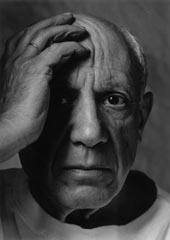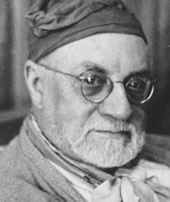“We must talk to each other as much as we can. When one of us dies, there will be some things the other will never be able to talk of with anyone else.”
– Henri Matisse to Pablo Picasso
KERA: Yve-Alain, some critics have written about Matisse and Picasso as though they represented opposite ends of the artistic spectrum. What’s wrong with that notion?

Pablo Picasso (© Arnold Newman/Liaison Agency)
KERA: What was behind Picasso’s early perceptions of Matisse? How did the rivalry start?
Yve-Alain Bois: I think that Picasso felt that, you know, this guy was really powerful and he didn’t want to be left behind. Picasso was extraordinarily ambitious, and he had already achieved quite a lot of success. And he knew that Matisse was a big obstacle in the road that Picasso had chosen for himself. Picasso wanted to become the most powerful avant-garde painter in Paris at the time, and so this very clear element of rivalry occurs very early in their relationship.
KERA: And later on, the rivalry was intensified by people in Picasso’s circle who began to ridicule Matisse openly.
Rick Brettell: Picasso never, ever had a conventional bourgeois life. I mean, though he was married, and though he had children several times, he lived outside the strictures of conventional morality. And therefore he could construct his own social life, because you know Madame Picasso was not such an important deal, and the kids were not such an important deal. What was important to him were the informal friendships of dealers, collectors, critics, friends, and hangers on.
With Matisse, on the other hand, even though in the 20’s the kids are getting older, and perhaps he’s a little bored with Madame Matisse, his sense of being a pater familia and of being bourgeois, of being correct, is a very important part of Matisse’s life. And for that reason alone, almost for the social reasons, it was very easy for the young, ne’er-do-wells, sexually libertine, socially libertine, foreign artists in Paris to make fun of, you know, the old guy who’s down in Nice painting odalisques because he can’t get it up with his wife anymore. I mean it’s fairly easy to make fun of Matisse during this period of time.

Henri Matisse (The Pierre Matisse Gallery Archives, The Pierpont Morgan Library, New York, MA 5020/Art Resource)
Rick Brettell: Matisse, like all artists, has moments of confidence and then moments of doubt. And that has a lot to do with modernism. Mearleau-Ponty wrote this great essay called “Cezanne’s Doubt” that’s about how self-doubt is actually one of the principal ingredients of modernism, because if you feel comfortable with what you’re doing, then you do it in a way which is rote and formulaic. And if you don’t feel comfortable with what you’re doing, if you’re your own worst critic, and if you chose to pit yourself against other artists who you perceive as being stronger, then your chance of actually doing something original and important is much better.
No matter who you are, if you’re forced by your age, and by the circumstances of your fame, to confront yourself entirely, then there’s the possibility of clutching, particularly when you’ve clutched before. And there was a monumental clutch, and a fear of failure, and of not knowing where you were going. And that’s the most interesting time in Matisse’s career, I think.
Yve-Alain Bois: So, you can imagine, Matisse is in isolation in Nice; he doesn’t want to speak to anyone; he can’t paint. And here you are, with Picasso churning out one work after another that alludes to Matisse’s early work. Can you imagine how irritating that must be? It seems to me that you have to overcome your misery by fighting back, which I think is exactly what Matisse did.
KERA: Why did Picasso pick on Matisse?
Rick Brettell: Who else is there to pick on? Why pick on Matisse? A little bit because he’s down and out. A little bit because he really is greater than anybody else anyway. I mean you can’t pick on Braque anymore. You can’t pick on Leger. I mean the surrealists are a bunch of young punks who aren’t doing much of anything anyway. I mean, can you imagine taking Salvador Dali seriously if you’re Picasso, a painter like Picasso? I mean, who do you engage?
And you know, when you engage somebody else in that way, it means that you need it too. You need that engagement. And clearly Picasso felt as if he himself had gone through a kind of eclectic and formless decade. And so, the two of them did need each other. Each of them thought that the other was a giant. So what’s wrong with sparring with a giant? It makes you stronger.
Yve-Alain Bois: In some ways, Picasso was bored, and he wanted Matisse back in the ring, and he wanted to find a way to get the old man out of his den. That’s what he did. He did it in various ways, and one of them was by caricaturing some of Matisse’s previous work. And he would always quote Matisse’s style from let’s say 1906-1914. I mean, he was telling Matisse, “Why don’t you do the same thing that you’re doing now, but the way you used to do it, in the style you used to use before? It would be much more interesting.”
KERA: And the dialogue continued for the next twenty-five years…
Rick Brettell: Yve-Alain’s exhibition celebrates the last third of their careers. There’s a feeling that they’ve transcended mere fashion. All these younger artists are barking up trees that they no longer have to bark up. The exhibition deals with the mature phase in the history of two artists whom we are taught to think of as opposites. And it makes us realize that though they are in many ways opposites, one feeds the other. It’s almost like a love affair in a way, because nobody else could inspire them as much as they could inspire each other.
Yve-Alain Bois: I think it’s rather interesting to think of their relationship as a sibling rivalry. I see Matisse and Picasso that way a lot.
Rick Brettell: They each wanted to dominate the other. And nobody wanted to win. I don’t see Matisse and Picasso as friends. I see them as being archetypal rivals, sort of friendly rivals.
Yve-Alain Bois: Chess is a very interesting metaphor for explaining the relationship between two artists like Matisse and Picasso. They needed the challenge of an adversary in order to become better themselves. They knew it.
KERA: And then Matisse dies, and Picasso goes through a period of mourning, painting the series of interiors at his studio, La Californie, in memory of Matisse. What do you see in those paintings?
Rick Brettell: The notion of the old guy paying homage to the older guy now gone…I was just stunned. The black, I mean that spaceless, extraordinary black. One remembers Matisse’s blacks from 1910 and 1911, and Picasso remembered even that.
And it’s interesting that Picasso actually knew enough about grief, about the way in which any kind of expressive form plays a role in grief, to let himself grieve artistically, and to do it in a rather concerted way. And therefore to be able to have an end, so that he could go on.

